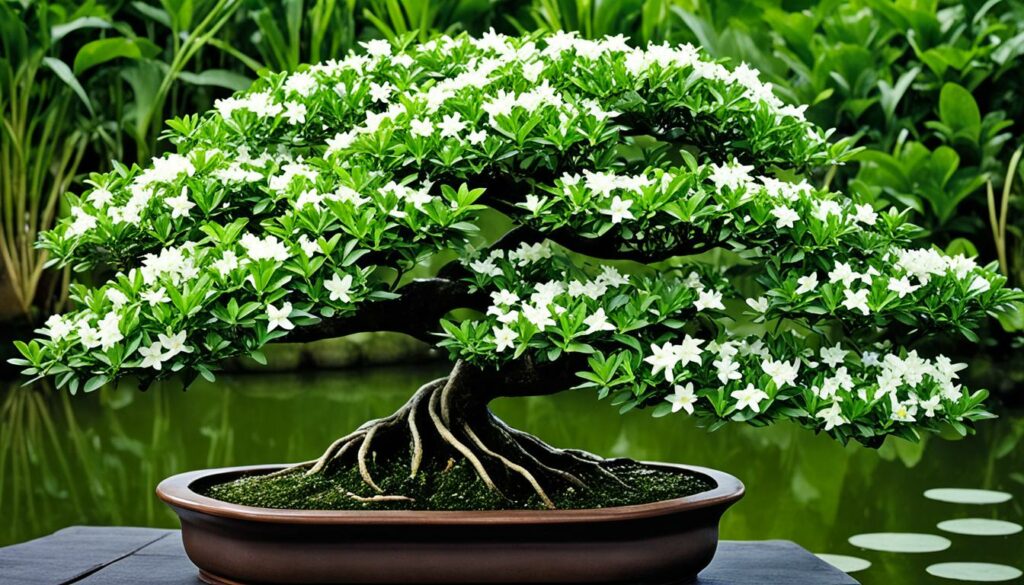If you’re a bonsai enthusiast, you’re likely always on the lookout for new and exciting species to add to your collection. One such species that should not be overlooked is the Water Jasmine bonsai, also known as Wrightia bonsai.
This tropical bonsai is renowned for its delicate beauty, exquisite fragrance, and elegant blooms. Despite its name, it’s not actually related to the Jasmine flower but shares its appealing scent.
In the following sections, we’ll explore the unique qualities, care requirements, and styling possibilities of the Water Jasmine bonsai so that you can decide if it’s the right addition to your bonsai collection.
Key Takeaways
- The Water Jasmine bonsai, also known as Wrightia bonsai, is a delicate and elegant tropical species.
- Water Jasmine bonsai is admired by bonsai enthusiasts for its charming fragrance and exquisite blooms.
- In the following sections, we’ll detail the unique qualities, care requirements, and styling options for the Water Jasmine bonsai to help you decide if it’s the right addition to your collection.
Understanding the Water Jasmine Bonsai
Water Jasmine, also known as Wrightia bonsai, is a tropical species originating from Southeast Asia, and has become a favored choice of bonsai enthusiasts worldwide. Its light grey bark, delicate green leaves, and fragrant white flowers make it an elegant addition to any collection.
As a tropical bonsai, it thrives in warmer temperatures, and it is a relatively fast grower, making it an ideal choice for beginners looking to hone their skills. Its small size also makes it a perfect option for indoor growers.
“The Water Jasmine (Wrightia religiosa) is a beautiful evergreen tree that originated in China and was then exported to Vietnam and other areas in Southeast Asia. The tree is known for its beautiful white flowers that bloom all year, creating a stunning contrast to the tree’s dark green leaves.”
Origins and Characteristics
The Water Jasmine is a small tree that can reach up to 10 feet in height in the wild but is usually kept much smaller as a bonsai. It is a hardy plant that can endure extremely high and low temperatures, making it a versatile species. It prefers well-draining soil and high humidity levels, and it requires regular pruning to maintain its desired shape.
Unique Qualities
One of the most unique features of the Water Jasmine bonsai is its exquisite fragrance. Its small white flowers produce a sweet scent that fills the air, making it a popular choice for those who want an aromatic bonsai. The Water Jasmine is also known for its elegant, graceful form, which makes it a popular option for traditional bonsai styles such as the windswept and cascade styles.
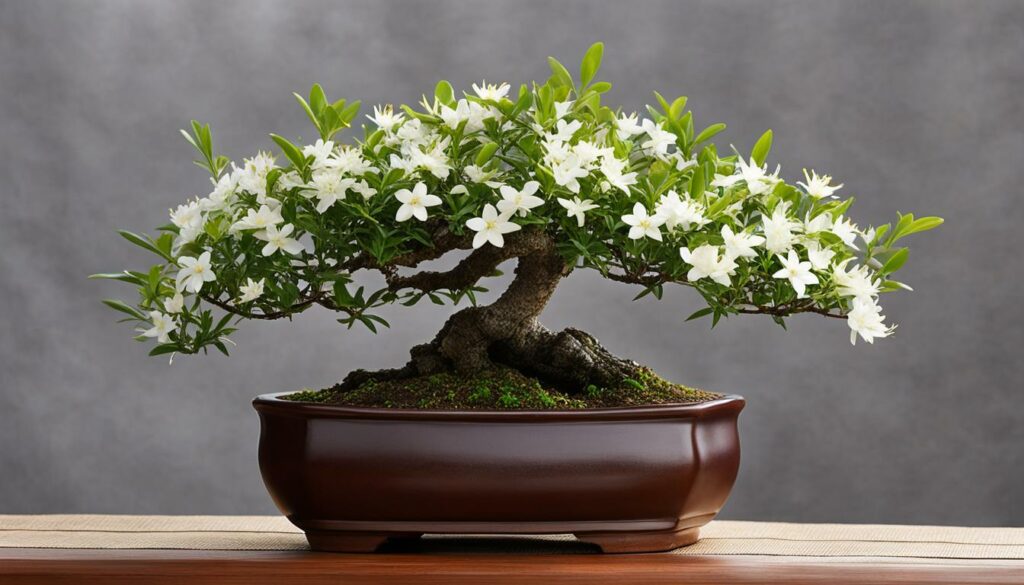
Cultivation Requirements
The Water Jasmine bonsai requires a warm, humid environment to thrive, making indoor growing ideal. It needs indirect, bright sunlight, and should not be exposed to extreme temperatures or direct sunlight for prolonged periods. A well-draining, nutrient-rich soil is essential, and regular fertilization and pruning are required to maintain its health and beauty.
The Art of Water Jasmine Bonsai Care
Proper care is crucial for bringing out the full beauty of your Water Jasmine bonsai. This tropical bonsai requires regular attention to thrive, but with some basic guidelines, you can easily keep it healthy and flourishing.
Watering
Your Water Jasmine bonsai needs regular watering, but be careful not to overwater it. The key is to maintain moist soil without letting it become waterlogged. Check the soil daily by inserting your finger into the soil; if it feels dry up to the second joint, it’s time to water. Use room temperature water to avoid damage to the roots. You can also mist the leaves occasionally to increase humidity.
Sunlight
Water Jasmine bonsai prefer bright but filtered light to direct sunlight. Place your bonsai in a location that receives bright morning light and shaded afternoon light. Too much direct sunlight can damage the leaves and cause leaf burn.
Pruning
Regular pruning is important to maintain the shape and size of your Water Jasmine bonsai. Pinch off new growth to encourage branching and shape the tree. Remove any dead or yellowed leaves to maintain the overall health of your bonsai. Use sharp pruning shears to avoid damaging the branches.
Repotting
Water Jasmine bonsai should be repotted every two to three years to prevent the roots from becoming congested. The best time to repot is in the early spring, just before new growth begins. Use well-draining soil, and remove any dead or tangled roots. After repotting, keep your bonsai in a shaded location for a few weeks until new growth appears.
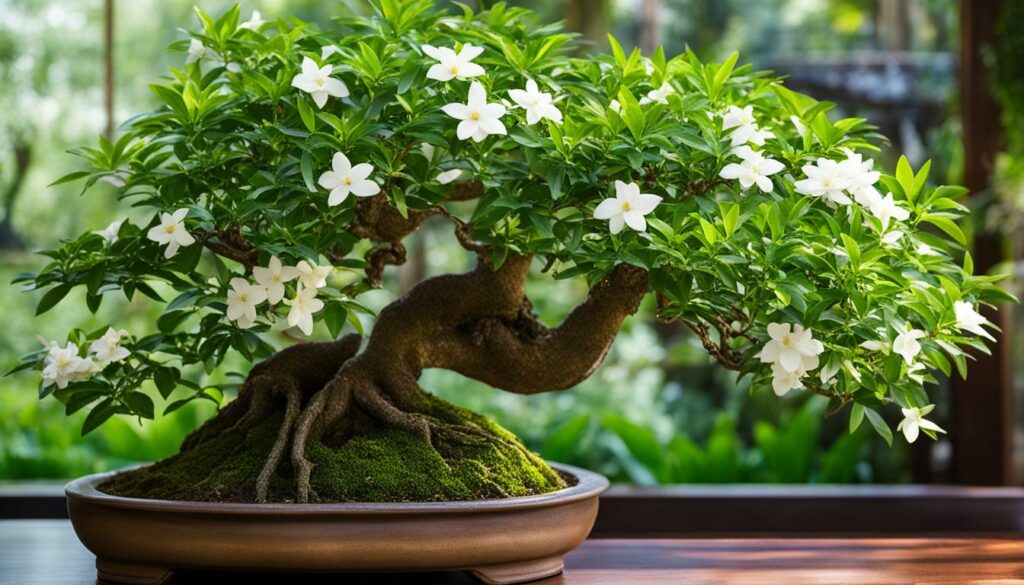
Tip: Keep a calendar or reminder to track watering, fertilizing, and pruning schedules for your Water Jasmine bonsai. This helps you stay consistent and provides a record of your bonsai’s growth and progress.
Creating the Perfect Environment for Your Water Jasmine Bonsai
The Water Jasmine bonsai thrives in tropical conditions, and creating the ideal environment is essential for its health and optimal growth. Here’s what you need to know:
| Requirement | Ideal Condition | Why It Matters |
|---|---|---|
| Temperature | Between 65°F and 80°F | The Water Jasmine prefers warm temperatures and cannot tolerate extreme heat or cold. |
| Humidity | Around 60% | High humidity levels are essential for the Water Jasmine to thrive, as it is native to humid tropical regions. |
| Soil | Well-draining, nutrient-rich soil | The Water Jasmine thrives in soil that is well-aerated and nutrient-rich, promoting healthy root growth and overall health. |
| Light | Bright, indirect light | The Water Jasmine requires ample light for photosynthesis, but overexposure to direct sunlight can scorch its leaves. |
| Protection | Sheltered from harsh weather | The Water Jasmine is delicate and cannot tolerate extreme weather conditions, such as heavy winds or frost. |
To achieve optimal temperature and humidity levels, consider investing in a humidifier and placing the bonsai on a tray of pebbles with water to increase moisture in the air. Additionally, providing shade during the hottest parts of the day can protect the Water Jasmine from excessive heat and direct sunlight.
Remember: Finding the perfect balance of temperature, humidity, and light can take time and experimentation. Monitor the Water Jasmine bonsai regularly and adjust conditions as needed to promote healthy growth and blooming.
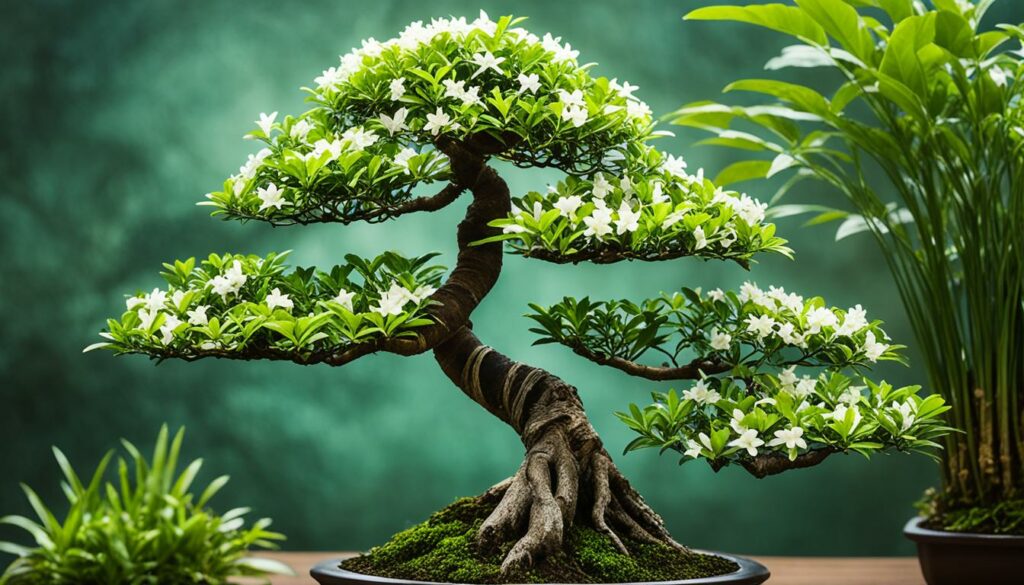
Propagation Methods for Water Jasmine Bonsai
Growing your collection of Water Jasmine bonsai can be a rewarding experience. Propagation is one way to expand your collection and try new techniques. In this section, we explore various methods for propagating Water Jasmine bonsai, including:
Cuttings
One common method for propagating Water Jasmine bonsai is through cuttings. Take a four to six-inch cutting from the tips or stems of an established Water Jasmine plant. Remove the lower leaves, leaving a few at the top. Dip the cut end in rooting hormone and insert into moist soil. Keep the soil damp and place in indirect sunlight. In a few weeks, roots should begin to grow, and you can transplant the cutting to a larger pot.
Air Layering
Air layering is another method for propagating Water Jasmine bonsai. Make a small cut on a stem and wrap it with moist sphagnum moss, securing it with plastic wrap. Roots will begin to grow from the cut, and once they have grown to a sufficient length, you can cut the stem below the moss and plant the new tree.
Seed Germination
For those who prefer a more hands-on approach, Water Jasmine bonsai can be propagated through seed germination. Purchase fresh seeds from a reputable supplier and soak them in warm water overnight. Sow the seeds in a well-draining soil mix and cover with a thin layer of soil. Keep the soil moist and place in indirect sunlight. In a few weeks, seedlings should emerge, and you can transplant them to larger pots as they grow.
Experimenting with propagation methods can help you discover new techniques and expand your collection of Water Jasmine bonsai. Always use sterile tools and materials to ensure successful propagation.
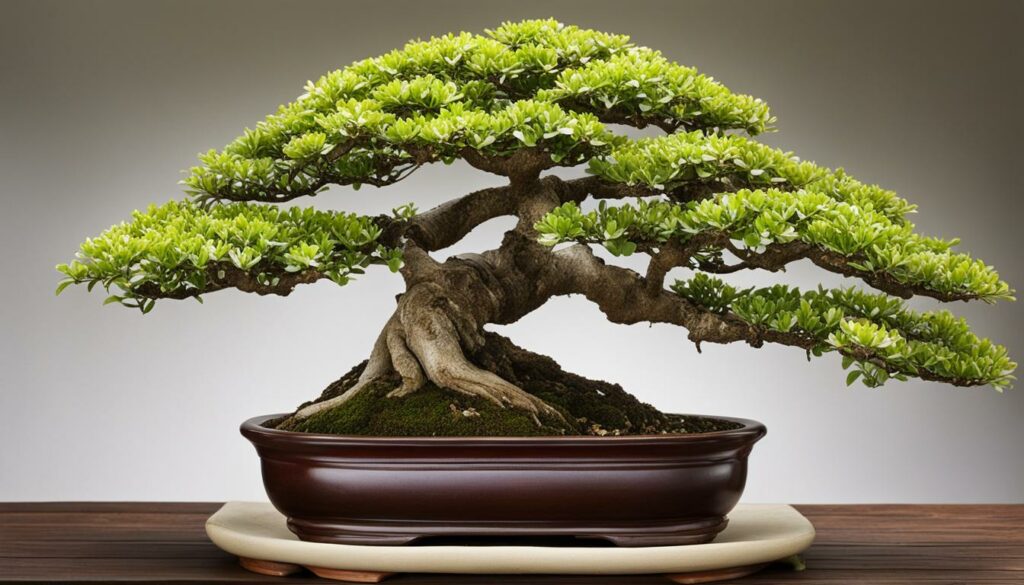
Training and Shaping the Water Jasmine Bonsai
Training and shaping the Water Jasmine Bonsai is an art that requires patience, attention to detail, and consistent care. The goal is to achieve a desired style and form while maintaining the health and overall gracefulness of the plant. This section offers guidance on the essential techniques needed to train and shape the Water Jasmine Bonsai.
One of the critical techniques in training a bonsai tree is wiring. By using wire, you can bend and manipulate the branches and trunk into a desired shape. It is essential to be gentle to avoid injury and to remove the wire once the branch has successfully trained into the desired position to prevent girdling.
Pruning is another crucial method for shaping a bonsai tree. By trimming the branches and leaves, you can control the size and density of foliage while shaping the tree’s overall form. The Water Jasmine Bonsai, being a flowering tropical bonsai, requires thinning of branches to promote more significant blooms on the remaining branches.
You can select branches that improve the aesthetic appearance of the trainer bonsai by using branch selection. This technique allows you to make the most of the tree’s unique traits and features while optimizing the placement of branches and foliage for overall balance and harmony.
Bonsai trees have specific styles that they’re trained to grow, showcasing their beauty. The Water Jasmine Bonsai can be trained into several different styles, with the most common styles being formal, informal, slanting, and cascading. Different bonsai tree styles require specific techniques like wiring, trimming, and positioning that will bring out the shape that you are looking for in that bonsai tree style.
Training and shaping Wrightia bonsai require the right tools and techniques. Learning those techniques will enable you to bring out the beauty of this tropical bonsai tree, allowing you to create different styles by simply wiring and pruning the branches and selecting the right positions. With consistent care, you can shape your Water Jasmine Bonsai into a beautiful and elegant display that will last many years.
Blooming and Flower Care of Water Jasmine Bonsai
The Water Jasmine bonsai is a delicate species that produces elegant and fragrant flowers. With proper care and attention, you can promote and maximize the blooming frequency of your flowering bonsai.
One of the crucial factors in promoting blooming is providing adequate sunlight. The Water Jasmine bonsai thrives in bright, indirect sunlight. You can also supplement natural light with artificial grow lights. Be sure to avoid placing your bonsai in direct sunlight, which can scorch its leaves and delicate flowers.
Another essential aspect of flower care is proper watering. The Water Jasmine bonsai prefers consistently moist soil, but avoid overwatering, which can lead to root rot. Depending on the ambient temperature and humidity, you may need to adjust your watering routine to prevent under or overwatering.
To ensure that your Water Jasmine bonsai produces beautiful and healthy flowers, it is essential to fertilize it regularly. Use a balanced bonsai fertilizer during the growing season to encourage blooming and overall growth. You can reduce fertilization during the dormant period.
Trimming and pruning are also vital for promoting blooming and overall health. Avoid allowing the branches and foliage of your bonsai to become too dense, which can obstruct light and impede blooming. Regular pruning also helps to promote the growth of new shoots and branches, leading to a healthier and more aesthetically pleasing bonsai.
By implementing these tips and techniques, you can enjoy the exquisite beauty and fragrance of your Water Jasmine bonsai’s blooming flowers all year round.
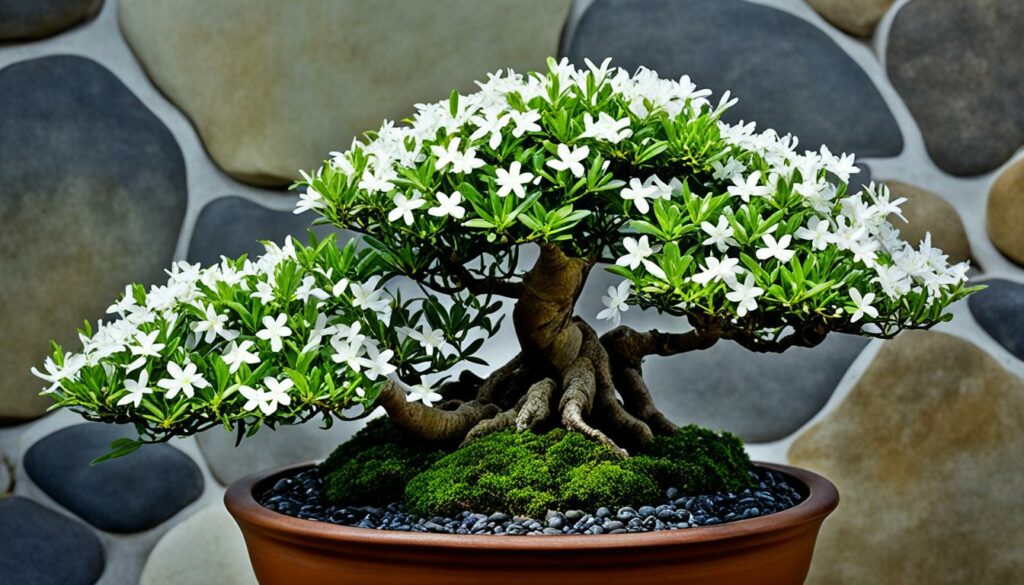
Pests and Diseases: Protecting the Water Jasmine Bonsai
When it comes to tropical bonsai like the Water Jasmine, keeping pests and diseases at bay is crucial for maintaining a vibrant and healthy plant. Here are some common pests and diseases you may encounter with your Water Jasmine bonsai and ways to prevent and treat them:
| Pest/Disease | Symptoms | Treatment |
|---|---|---|
| Spider Mites | Yellowing leaves, fine webbing | Wash leaves with water or use insecticidal soap |
| Whiteflies | Yellowing leaves, sticky residue on leaves | Use sticky traps or insecticidal soap |
| Fungal Infections | Black spots on leaves, wilted foliage | Remove infected leaves and use fungicide |
| Root Rot | Wilting foliage, brown and mushy roots | Reduce watering frequency and use a well-draining soil mix |
Regular inspection and proper care can help prevent most pests and diseases from affecting your Water Jasmine bonsai. Remember to always remove any dead or infected leaves and stems, and promptly address any issues that arise. With diligent care, your Water Jasmine will thrive for years to come.
Styling Ideas and Displaying Your Water Jasmine Bonsai
Now that you have care tips for your Water Jasmine bonsai, let’s talk about how to style and display your beautiful creation. Choosing a suitable pot or stand is the first step in showcasing the beauty of your bonsai. You can choose from a variety of containers made of traditional ceramic, rustic wood, or sleek metal.
Avoid contrasting colors or flashy designs that detract from the elegance of your Water Jasmine bonsai. Instead, opt for neutral or natural hues that complement the delicate blooms and foliage.
The placement of your bonsai is equally important in displaying its beauty. Your Water Jasmine bonsai thrives in bright but indirect light, so make sure you choose a spot in your home or office that provides these conditions. You can also place a small humidifier nearby to maintain adequate moisture levels.
A beautiful stand can give your Water Jasmine bonsai a prominent and well-deserved position in any living space. You can choose a wooden stand that adds warmth and texture, or a metal stand that adds a sleek and modern touch. Be sure to match the style and color of the stand with the decor of the room where it will be displayed.
Creating a captivating bonsai display is an art that requires a bit of planning and creativity. You can showcase your Water Jasmine bonsai alongside other bonsai species or potted plants in group displays. Another option is to showcase your bonsai on a tiered shelf that allows each specimen to stand out.
Finally, keep in mind that the beauty of your Water Jasmine bonsai lies not only in its blooms and foliage but also in the artful care and nurturing it receives. Displaying your bonsai in a prominent and thoughtful way will not only enhance its beauty but also give it a well-deserved spotlight in any space it inhabits.
Appreciating the Beauty and History of Water Jasmine Bonsai
The Water Jasmine bonsai has a rich history and cultural significance that runs deep. This tropical bonsai is native to Southeast Asia and was first introduced to Japan during the Nara period (710-794).
Known for its beauty, elegance, and delightful fragrance, the Water Jasmine bonsai holds a special place in traditional Japanese bonsai art and culture. In Japan, this species is referred to as “mame-jaku”, meaning “bean-sized strength”. This name refers to the remarkable strength and resilience of the delicate Water Jasmine bonsai.
The Water Jasmine bonsai is also significant in Hindu mythology, where it is known as “Dwarflingam” or “Kundalini”. According to legend, the god Vishnu created the bonsai to celebrate the birth of the goddess Lakshmi, who represents beauty, fertility, and prosperity.
Today, the Water Jasmine bonsai continues to inspire and captivate bonsai enthusiasts around the world. Whether displayed as a standalone piece or incorporated into a larger collection, this tropical bonsai is a symbol of beauty, resilience, and grace.
Expanding Your Bonsai Collection with Water Jasmine
Incorporating a Water Jasmine bonsai into your collection is a great way to diversify and enhance your bonsai experience. This tropical bonsai species, also known as Wrightia bonsai, adds a unique touch of elegance and sophistication to any bonsai display.
One of the benefits of adding Water Jasmine to your collection is its versatility. This species can be trained and shaped in a variety of styles, from formal upright to informal cascade. Its small leaves and delicate flowers make it a popular choice for creating intricate designs and displays.
When sourcing a Water Jasmine tree for your collection, it’s important to select a healthy specimen with well-established roots. Look for a plant that has a thick trunk and dense foliage, with no signs of pests or diseases. Online bonsai vendors and local specialty nurseries are great resources for high-quality Water Jasmine trees.
Another option for expanding your bonsai collection with Water Jasmine is through propagation. This species can be easily propagated through cuttings and air layering techniques, allowing you to grow multiple trees from a single plant.
Overall, adding a Water Jasmine bonsai to your collection can bring a touch of exotic beauty and uniqueness to your bonsai hobby. With proper care and cultivation, this tropical bonsai species can thrive and become a beloved addition to your collection.
The Future of Water Jasmine Bonsai
As bonsai cultivation continues to gain popularity globally, the future of Water Jasmine bonsai appears bright. With its delicate beauty and unique character, this tropical bonsai species is sure to captivate enthusiasts for years to come.
As advancements in technology and horticulture continue, we can expect to see new techniques and tools emerge for cultivating and caring for the Water Jasmine bonsai. From innovative soil mixes and fertilizers to smart irrigation systems and app-based care guides, the future of Water Jasmine bonsai care promises to be exciting and dynamic.
In addition, as more collectors and growers incorporate Water Jasmine bonsai into their collections, we can expect to see a greater diversity in forms and styles. From cascading and windswept forms to formal upright and informal styles, the Water Jasmine bonsai offers endless possibilities for artistic expression.
Overall, the future of Water Jasmine bonsai is bright, and we can look forward to continued growth and development in this beloved tropical bonsai species.
FAQ
What is the Water Jasmine bonsai?
The Water Jasmine bonsai, also known as Wrightia bonsai, is a tropical bonsai tree species. It is highly regarded for its delicate nature, exquisite fragrance, and elegant blooms.
Where does the Water Jasmine bonsai originate from?
The Water Jasmine bonsai is native to Southeast Asia, including countries like Thailand, Vietnam, and the Philippines.
How do I care for a Water Jasmine bonsai?
Proper care for a Water Jasmine bonsai includes watering it regularly, providing it with the right amount of sunlight, pruning it to maintain its shape, and repotting it when necessary.
What are the ideal growing conditions for a Water Jasmine bonsai?
The Water Jasmine bonsai thrives in temperatures between 60 and 80 degrees Fahrenheit. It requires a high level of humidity and well-draining soil. It should also be protected from extreme weather conditions.
How can I propagate a Water Jasmine bonsai?
There are several methods of propagating a Water Jasmine bonsai, including using cuttings, air layering, and seed germination.
How do I train and shape a Water Jasmine bonsai?
Training and shaping a Water Jasmine bonsai involve techniques such as wiring, pruning, and selecting the right branches to create the desired bonsai style and form.
How can I promote blooming in my Water Jasmine bonsai?
To promote blooming in a Water Jasmine bonsai, it is important to provide it with the right amount of sunlight, water, and fertilization. Some additional techniques, such as pinching back new growth, can also stimulate blooming.
What pests and diseases should I be aware of when caring for a Water Jasmine bonsai?
Common pests that can affect a Water Jasmine bonsai include aphids, scales, and spider mites. Diseases such as powdery mildew and root rot can also pose a threat. Regular inspection and appropriate treatments can help protect the bonsai from these issues.
How can I display my Water Jasmine bonsai?
To showcase the beauty of a Water Jasmine bonsai, consider choosing a suitable pot and stand. Experiment with different display ideas and create captivating bonsai displays that highlight the elegance of the tree.
What is the cultural significance of the Water Jasmine bonsai?
The Water Jasmine bonsai holds cultural significance in traditional bonsai art. It is admired for its symbolism of elegance, grace, and the ephemeral beauty of nature.
Can I expand my bonsai collection with the Water Jasmine bonsai?
Yes, adding a Water Jasmine bonsai to your collection can bring diversity and beauty. It offers a unique fragrance and delicate blooms that can complement other bonsai species.
What does the future hold for Water Jasmine bonsai?
The cultivation and care of Water Jasmine bonsai continue to evolve. Advancements in techniques and technology, as well as the growing popularity of bonsai, promise an exciting future for this remarkable bonsai species.
